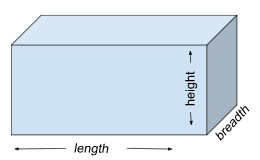
 Data Structure
Data Structure Networking
Networking RDBMS
RDBMS Operating System
Operating System Java
Java MS Excel
MS Excel iOS
iOS HTML
HTML CSS
CSS Android
Android Python
Python C Programming
C Programming C++
C++ C#
C# MongoDB
MongoDB MySQL
MySQL Javascript
Javascript PHP
PHP
- Selected Reading
- UPSC IAS Exams Notes
- Developer's Best Practices
- Questions and Answers
- Effective Resume Writing
- HR Interview Questions
- Computer Glossary
- Who is Who
Golang program to Calculate the Volume, Diagonal and Area of a Cuboid?
In this tutorial, we will discuss the approach to calculating the volume, diagonal and area of a cuboid using its length, breadth and height.
But before writing its Golang code, let's briefly discuss the cuboid and its volume, diagonal and area.
Cuboid
A cuboid is a three?dimensional figure with six faces and twelve edges. The length, breadth, and height of a cuboid are different unlike a cube whose all sides are equal. A rectangular box is a good example of a cuboid.

Volume of a Cuboid
The amount of space a cuboid occupies is termed its volume. Calculating the volume of a cuboid can be beneficial in situations where we want to know how much air can be accumulated in a room.
Volume = l * b * h
Diagonal of a cuboid
The diagonal of a cuboid can be defined as the line segment joining two opposite vertices of the cuboid.
$$\mathrm{Diagonal\: = \:\sqrt({l^2 + b^2 +h^2})}$$Area of a cuboid
The total area occupied by the cuboid is known as the area of the cuboid.
Area = 2 * (l * h + l * b + h * b)
Example
-
Length = 10, Breadth = 3, Height = 5
Volume of cuboid = 150
Diagonal of cuboid = 11.575836902790225
Area of cuboid = 190
Explanation
$\mathrm{Volume\: of\: cuboid \:= \:l * b * h}$
$\mathrm{= \:10 * 3 * 5}$
$\mathrm{=\: 150}$
$\mathrm{Diagonal\: of\: cuboid\: = \:\sqrt({l^2 + b^2 +h^2})}$
$\mathrm{\:\sqrt({l0^2 +3^2 +5^2})}$
$\mathrm{= 11.575836902790225}$
$\mathrm{Area\: of\: cuboid\: = \:2 * (l * h + l * b + h * b)}$
$\mathrm{= \:2 * (10 * 5 + 10 * 3 + 5 * 3)}$
$\mathrm{= \:190}$
Calculating the Volume, Diagonal and Area of a Cuboid
Step 1 ? Declare three variables for storing the length ?l', breadth ?b', and height ?h' of the cuboid.
Step 2 ? Declare three variables for storing the volume of the cuboid? ?volume', diagonal ?diag' and area of the cuboid? ?area' and initialize all the three variables with the value 0.
Step 3 ? Calculate the volume using the formula? Volume = l * b * h, and store it in the ?volume' variable in the function calculateVolumeOfCuboid().
Step 4 ? Calculate the diagonal using the formula? Diagonal = ?(l2 + b2 +h2), and store it in the ?diag' variable in the function calculateDiagonalOfCuboid().
Step 5 ? Calculate the area using the formula? Area = 2 * (l * h + l * b + h * b), and store it in the ?area' variable in the function calculateAreaOfCuboid().
Step 6 ? Print the calculated volume, diagonal and area of the cuboid, i.e, the value stored in the ?volume', ?diag' and ?area' variables.
Example
package main
import (
"fmt"
"math"
)
func calculateVolumeOfCuboid(l, b, h float64) float64 {
var volume float64 = 0
volume = l * b * h
return volume
}
func calculateDiagonalOfCuboid(l, b, h float64) float64 {
var diag float64 = 0
diag = math.Sqrt((l * l) + (b * b) + (h * h))
return diag
}
func calculateAreaOfCuboid(l, b, h float64) float64 {
var area float64 = 0
area = 2 * ((l * h) + (l * b) + (h * b))
return area
}
func main() {
var l, b, h float64 = 10, 3, 5
var volume, diag, area float64
fmt.Println("Program to calculate the volume, diagonal and area of the Cuboid \n")
volume = calculateVolumeOfCuboid(l, b, h)
diag = calculateDiagonalOfCuboid(l, b, h)
area = calculateAreaOfCuboid(l, b, h)
fmt.Println("Length of the cuboid: ", l)
fmt.Println("Breadth of the cuboid: ", b)
fmt.Println("Height of the cuboid: ", h)
fmt.Println("Therefore, Volume of cuboid: ", volume)
fmt.Println("Diagonal of cuboid: ", diag)
fmt.Println("Area of cuboid: ", area)
}
Output
Program to calculate the volume, diagonal and area of the Cuboid Length of the cuboid: 10 Breadth of the cuboid: 3 Height of the cuboid: 5 Therefore, Volume of cuboid: 150 Diagonal of cuboid: 11.575836902790225 Area of cuboid: 190
Description of Code
calculateVolumeOfCuboid(l, b, h float64) float64 ? This function will calculate the volume of the cuboid. It has a return type of float64.
diag = math.Sqrt((l * l) + (b * b) + (h * h)) ? Using this formula, we are calculating the diagonal. We are using the Sqrt function from the math package to do the square root.
Conclusion
This is all about calculating the volume, diagonal and area of a cuboid using Go programming. We have also maintained code modularity by using separate functions for calculating the area, diagonal and volume which also increases the code reusability. You can explore more about Golang programming using these tutorials.

